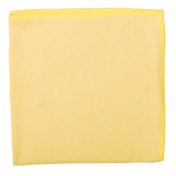Using chamois leather to clean windows has many advantages. The particularly soft and absorbent texture guarantees streak-free cleaning . In addition to these properties, chamois leather is a little more expensive to purchase, but with the right care it is much more durable than microfiber cloths or other window cleaning cloths . How such a chamois leather is made and what optimal care looks like is explained in this blog entry.
The traditional manufacturing process
Chamois leather is a so-called chamois leather . The word "semi" comes from the Dutch and means particularly soft. The traditional way of producing chamois leather has been around for many centuries. The sheep and lamb skins to be processed often come from New Zealand, England or Ireland . First of all, the skins are preserved in salt and then soaked in water for a few days. A lime broth is then made in which the skins are soaked for four to six weeks. After this time, the hair is loose and can now be dehaired either by machine or by hand.
Crucial production step: liming
After all the hair has been removed, the leather must be limed. This means that the hide or leather is stripped of subcutaneous connective tissue and scar layers. This process is crucial for the properties of the leather . The softer the leather is to be in the end, the more the fiber structure of the skin must be opened up. This in turn means that the longer the limed process takes, the softer the material. After this step, pure leather, the so-called pelt , is produced. However, preserved leather is required for consumption.
The last step of preparation: watering
Next, the pelts must be thoroughly watered to remove the lime. In the traditional production process, the pelts are hung in the stream and then the water is removed using a wringer. These steps were just the preparatory work, which took about three months.
Final spurt in the production of chamois leather: fulling
The tanning agent cod oil, which comes from the fatty oils of cod, is used to tan chamois leather. The tanning agent is hammered into the leather during the fulling process and is used, for example, to protect it from rot. During fulling, heavy hammers hammer the hides so that the cod oil stays in the leather. A fulling process takes around 12 hours and is repeated for around four weeks. In between, the leather is hung up and dried. After these four weeks, the leather is finished, so to speak. The leather now receives its finishing touches. It is softened, roughened, and dyed as desired. With this traditional method, the customer ultimately receives leather of excellent quality. The entire tanning process can take up to a year, but there are now quicker and easier ways, although the quality can suffer.
care instructions
To ensure that a chamois leather lasts as long as possible and the investment is particularly worthwhile, you should follow the following care instructions:
- Before first use: soak in lukewarm water, soap and a tablespoon of salt. Then rinse well until the water is clear.
- After use: immediately after use, soak in soap, lukewarm water and salt for about 1 to 2 hours. Now rub in water, wash out and rinse well. Allow the leather to air dry!
- Warning: Heat damages the leather, so never use water over 30°C. Do not strangle the leather to death, otherwise the fibers will tear.
- If necessary, special leather detergent or leather soap can be used. The application instructions should be followed.
Practical tool for crystal-clear window cleaning
In summary, it can be said that the production of such a chamois leather is time-consuming and complex. This explains the high price of chamois leather or any other leather item. In addition, the leather will last a long time if it is treated like a second skin and is well cared for.



